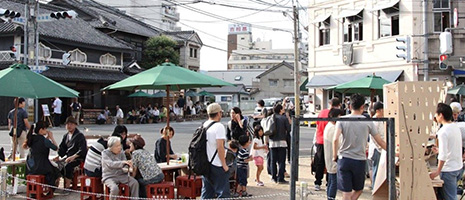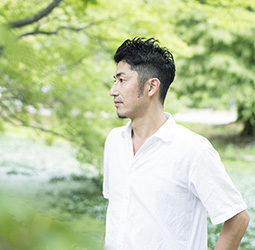Home > Highlighting JAPAN > Highlighting Japan February 2017 > New Pioneers of Local Development
Highlighting JAPAN


A Tale of Two Cities
Architect Toshio Yada, who divides his time between Tokyo and Okayama, works on regional revitalization, making use of regional cultural resources.
Currently, with its population concentrated in the Tokyo metropolitan district, Japan is facing a rapidly declining number of children and aging population, depopulation due to these factors and the shrinking of the economy. To improve this situation, Japan faces a significant challenge in terms of how to revitalize the local regions.
Recently, an increasing number of people have begun to move their career bases from Tokyo to the local regions to work on local revitalization. Architect Toshio Yada is one of them. In 1998, after completing a Kyoto University Graduate School course, Yada joined a design office managed by Kengo Kuma, who is a world-famous architect, and participated in architectural projects at the Suntory Museum of Art and the Nezu Museum in Tokyo and in other countries including China.
In 2010, Yada was invited by Okayama University of Science in Okayama to assume the post of associate professor in the Department of Architecture, which prompted him to leave the design office of Kuma and open his own office in Tokyo. In April 2011, immediately after the Great East Japan Earthquake, Yada began undertaking educational and research activities at Okayama University of Science.
“One of the reasons why I decided to work in Okayama was that I wanted to look at things from two activity bases, Tokyo and Okayama. Precisely at that time, northern Japan was struck by a massive earthquake, which made me feel that it was all the more necessary to divide my time between the two activity bases,” says Yada. “Okayama is less prone to natural disasters, and it is a very good location. The city is neither too urban nor too rural, and its size is perfect. It is also a convenient base for traveling to many other parts of the country.”
Yada began to spend half of each month in Tokyo and the other half of each month in Okayama with his wife (a photographer) and their child, traveling back and forth between the two cities in about three and a half hours by bullet train. In addition, he also established an NPO called ENNOVA OKAYAMA comprising about ten members, including people from Okayama and elsewhere, in order for local people to gain an awareness of how attractive Okayama is.
As one of its activities, ENNOVA OKAYAMA collaborates with the Okayama City government in implementing a project utilizing a closed elementary school and Ishiyama Park, which is adjacent to the school. Within the closed school, they hold events such as workshops, concerts and theatrical plays using the school buildings and the school grounds. In the park, they run an open cafeteria and hold a flea market that hosts shops selling food, accessories and clothes.
In addition, as an associate professor from Okayama University of Science, Yada also participates in a project for reproducing and utilizing Fukuoka Soy Sauce Factory in Izushi-cho, which is adjacent to Okayama Korakuen, one of the three greatest gardens of Japan, with his students and local citizens. Fukuoka Soy Sauce Factory was built from the mid-Meiji period (1868–1912) until the early Showa period (1926–1989) and was used as a soy sauce brewery and a residence, but the building is now vacant. To preserve Fukuoka Soy Sauce Factory, a landmark of Izushi, members of the Project Steering Committee including Yada organized a clean-up of the building with the neighboring residents and held workshops to discuss how best to utilize it. They have also held dining events in the building on six occasions to date.
“The building is situated in a prime location in the city. Unless we work to preserve the building, it may be demolished and a new building may be constructed,” says Yada. “We believe Fukuoka Soy Sauce Factory will be able to become a center for creating charm for the local community. If we can succeed in preserving and renovating the building, we will be able to produce a positive impact on attractive city development in the region.”
Along with these activities in Okayama, Yada is also involved in designing structures in other local regions. For example, he managed the extension and renovation of the Treasure Hall within the grounds of the 1,300-year-old Kasuga-taisha grand shrine, a World Heritage site in Nara Prefecture. The extension and renovation project was completed in October 2016 and reopened as Kasuga-taisha Museum. Two huge, brightly colored taiko drums were placed in the glass entrance hall, attracting a lot of attention from people walking within the grounds.
“I will continue to take on new challenges based in both Tokyo and Okayama,” says Yada. “If there are more people who have two activity bases like me, there will be more new human networks and communications nationwide, which will make the whole of Japan more attractive.”
© 2009 Cabinet Office, Government of Japan








